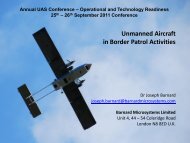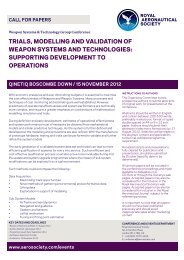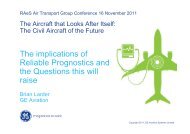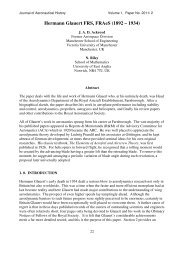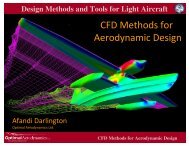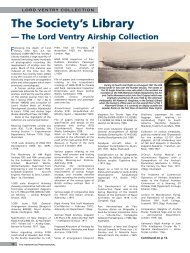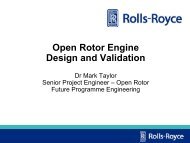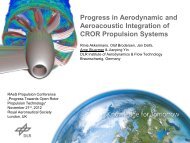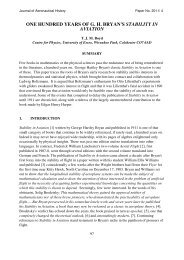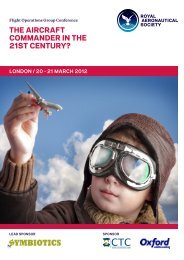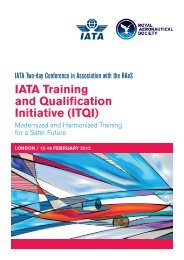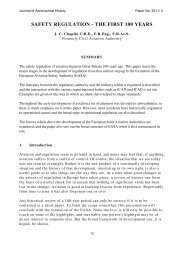Air to Air Refuelling in Civil Aviation, An Opportunity & A Vision Dr ...
Air to Air Refuelling in Civil Aviation, An Opportunity & A Vision Dr ...
Air to Air Refuelling in Civil Aviation, An Opportunity & A Vision Dr ...
Create successful ePaper yourself
Turn your PDF publications into a flip-book with our unique Google optimized e-Paper software.
second is the basic cost of convert<strong>in</strong>g say, an A330<br />
or B767 <strong>in</strong><strong>to</strong> a civil MRTT. The cost will be<br />
appreciable but not restrictive.<br />
The possibility of convert<strong>in</strong>g an exist<strong>in</strong>g airl<strong>in</strong>er<br />
<strong>to</strong> a pure freighter is fac<strong>to</strong>red <strong>in</strong> <strong>to</strong> the life cycle of<br />
most types. The additional cost of <strong>in</strong>clud<strong>in</strong>g AAR<br />
and tank<strong>in</strong>g facilities is actually quite a small<br />
percentage of the <strong>to</strong>tal conversion cost. Freight<br />
doors and floor strengthen<strong>in</strong>g are the costly<br />
structural items. If, by utilis<strong>in</strong>g AAR, a technical<br />
s<strong>to</strong>p can be avoided then a valuable ATC slot can be<br />
traded or sold. At London, Heathrow (LHR), at<br />
peak time, a paired departure and arrival slot would<br />
be worth about £30 million.<br />
6. AN UNCONVENTIONAL<br />
CHALLENGING CONFIGURATION<br />
We have shown that maximum fuel efficiency is<br />
achieved by aircraft designed for approximately<br />
3000 nm range. Us<strong>in</strong>g AAR, this high efficiency<br />
can be ma<strong>in</strong>ta<strong>in</strong>ed over longer ranges. Currently,<br />
the B757 is a fuel-efficient aircraft. It carries 200 <strong>to</strong><br />
220 pax (s<strong>in</strong>gle-aisle) over 3000 nm. It may not<br />
offer adequate comfort for long-range flights.<br />
It is opportune <strong>to</strong> consider possible challeng<strong>in</strong>g<br />
unconventional designs, exploit<strong>in</strong>g the 3000nm<br />
range and the advantages afforded by AAR.<br />
A current <strong>in</strong>terest is the design of moderate<br />
range aircraft, broadly <strong>in</strong> the class of the <strong>Air</strong>bus<br />
A320 series. We aim at 220 seats (as <strong>in</strong> A321) <strong>in</strong> an<br />
economy tw<strong>in</strong>-aisle cab<strong>in</strong>. This implies a shorter,<br />
stubbier, fuselage than the A321. With emphasis on<br />
fuel-efficient flight, the Range parameter (X = V.<br />
(L/D)/SFC) needs <strong>to</strong> be <strong>in</strong>creased. For conventional<br />
layouts, although near matur<strong>in</strong>g technology levels,<br />
respectable ga<strong>in</strong>s are still feasible with lighter<br />
structures etc. It is always difficult <strong>to</strong> <strong>in</strong>clude<br />
radical changes <strong>in</strong> an established l<strong>in</strong>e!<br />
It may be useful <strong>to</strong> consider unconventional<br />
types such as a Jo<strong>in</strong>ed-W<strong>in</strong>g layout enabl<strong>in</strong>g a high<br />
aspect ratio (AR) w<strong>in</strong>g <strong>to</strong> improve L/D. Many<br />
related structural issues exist as shown <strong>in</strong> Fig.35,<br />
Ref.25. The jo<strong>in</strong> is at 0.6 y/s. The power-plant<br />
location offers several choices. The immediate<br />
benefit of reduced cab<strong>in</strong> noise afforded by rearmounted<br />
eng<strong>in</strong>es is evident.<br />
Structural <strong>in</strong>tegrity of fuselage or tail-mounted<br />
eng<strong>in</strong>es requires further thought. Similarly, the<br />
effects of thrust-l<strong>in</strong>e on high mounted eng<strong>in</strong>es<br />
compared with those at the fuselage side will have a<br />
bear<strong>in</strong>g on w<strong>in</strong>g-tail location. Design considerations<br />
(structural and aero-elastics) need <strong>to</strong> <strong>in</strong>clude the<br />
height of the rear w<strong>in</strong>g and its jo<strong>in</strong> on the fuselage<br />
or vertical f<strong>in</strong>. <strong>An</strong> alternative proposal is with<br />
forward swept tips with a different set of<br />
compromises. All this will be an <strong>in</strong>terest<strong>in</strong>g future<br />
<strong>to</strong>pic. It may be useful <strong>to</strong> th<strong>in</strong>k also <strong>in</strong> terms of a<br />
strut-braced version.<br />
The ma<strong>in</strong> siz<strong>in</strong>g driver is the <strong>in</strong>tegration of a<br />
fuselage <strong>in</strong> a jo<strong>in</strong>ed-w<strong>in</strong>g layout coupled with the<br />
requirement for adequate fuel s<strong>to</strong>rage. The payload<br />
- range performance demands, therefore, lead <strong>to</strong><br />
reasonably thick aerofoils (t/c normal <strong>to</strong> the LE,<br />
between 12 and 15%) operat<strong>in</strong>g at moderately high<br />
CL values, near 0.6. Depend<strong>in</strong>g on w<strong>in</strong>g sweep,<br />
7<br />
thicker aerofoils can be adapted for hybrid lam<strong>in</strong>ar<br />
flow. Coupled with efficient propulsion, there is the<br />
prospect of 10-20% <strong>in</strong>crease <strong>in</strong> X. This <strong>in</strong> turn<br />
implies weight reductions / fuel efficiency ga<strong>in</strong>s.<br />
7. SUMMARISING, LIST FOR FIRST-<br />
LEVEL ANSWERS FROM DIFFERENT<br />
VIEWPOINTS<br />
It is useful <strong>to</strong> beg<strong>in</strong> a list emphasis<strong>in</strong>g the key<br />
features / benefits us<strong>in</strong>g AAR from different<br />
viewpo<strong>in</strong>ts. Some questions have been answered at<br />
a first level. Now is the time for <strong>in</strong>itiat<strong>in</strong>g serious<br />
studies. Most features are <strong>in</strong>ter-related. It is hoped<br />
that these will provide <strong>in</strong>sights <strong>in</strong><strong>to</strong> understand<strong>in</strong>g<br />
AAR operations / feasibility. No doubt, readers will<br />
contribute, with a positive outlook.<br />
AAR is a "multiplier" and Enabler<br />
- All efficiency improvements currently envisaged for<br />
future designs and upgrades will be enhanced<br />
- Co-exists with Close Fly<strong>in</strong>g Formations (CFF) ideas<br />
- Long range fuel consumption down 30%<br />
- Should enable Lam<strong>in</strong>ar (natural or hybrid) flow<br />
achievement (+15% say) with lesser penalties<br />
- Works naturally with Close Formation Fly<strong>in</strong>g. L/D up<br />
10%<br />
- Long range, direct flights enabled with full load, pax<br />
+ cargo. Fuel cost sav<strong>in</strong>gs: $175/pax for 6000nm<br />
with AAR, $320/pax for 9000nm with AAR<br />
(Assum<strong>in</strong>g fuel at $4.7/USG). Extend<strong>in</strong>g the sums<br />
<strong>to</strong> 250 seaters, fuel cost sav<strong>in</strong>gs are $43,750 and<br />
$80,000 for 6000nm and 9000nm flights<br />
respectively. Over a year, the sav<strong>in</strong>gs for 6000nm<br />
and 9000nm aircraft are $16 & $29 million<br />
respectively.<br />
- Life cycle costs halved<br />
- Service life extended<br />
- Costs of technical s<strong>to</strong>ps elim<strong>in</strong>ated<br />
- <strong>Air</strong>craft operate at max. payload, max. efficiency<br />
<strong>Air</strong>frame and eng<strong>in</strong>e manufacturers modify<br />
design requirements<br />
- More, smaller aircraft required (3000 nm range)<br />
- More, lower thrust and smaller eng<strong>in</strong>es<br />
- Alternative, more suitable airframe shapes may<br />
evolve (Jo<strong>in</strong>ed-w<strong>in</strong>g)<br />
Smaller (and more uniform) aircraft imply<br />
- Reduced wake strength (function of weight and span<br />
or cav, given CL)<br />
- Reduced separation time, Increased frequency of<br />
aircraft movements<br />
- Reduced lateral translation of wake (ground effect)<br />
- Improved utilisation of adjacent runways<br />
- Reduced thrust requirements, climb quickly <strong>to</strong><br />
requisite best altitude<br />
- Less eng<strong>in</strong>e noise, <strong>in</strong>crease night fly<strong>in</strong>g capability<br />
- More movements from a given airport (up by 30%)<br />
- Fire hazard less with smaller aircraft, easier on<br />
Equipment (<strong>Aviation</strong> Week, 2008)<br />
Opera<strong>to</strong>rs modify procedures<br />
- Reduced <strong>in</strong>vestment needed (smaller airframes cost<br />
less)<br />
- Operate at maximum payload for maximum<br />
efficiency



